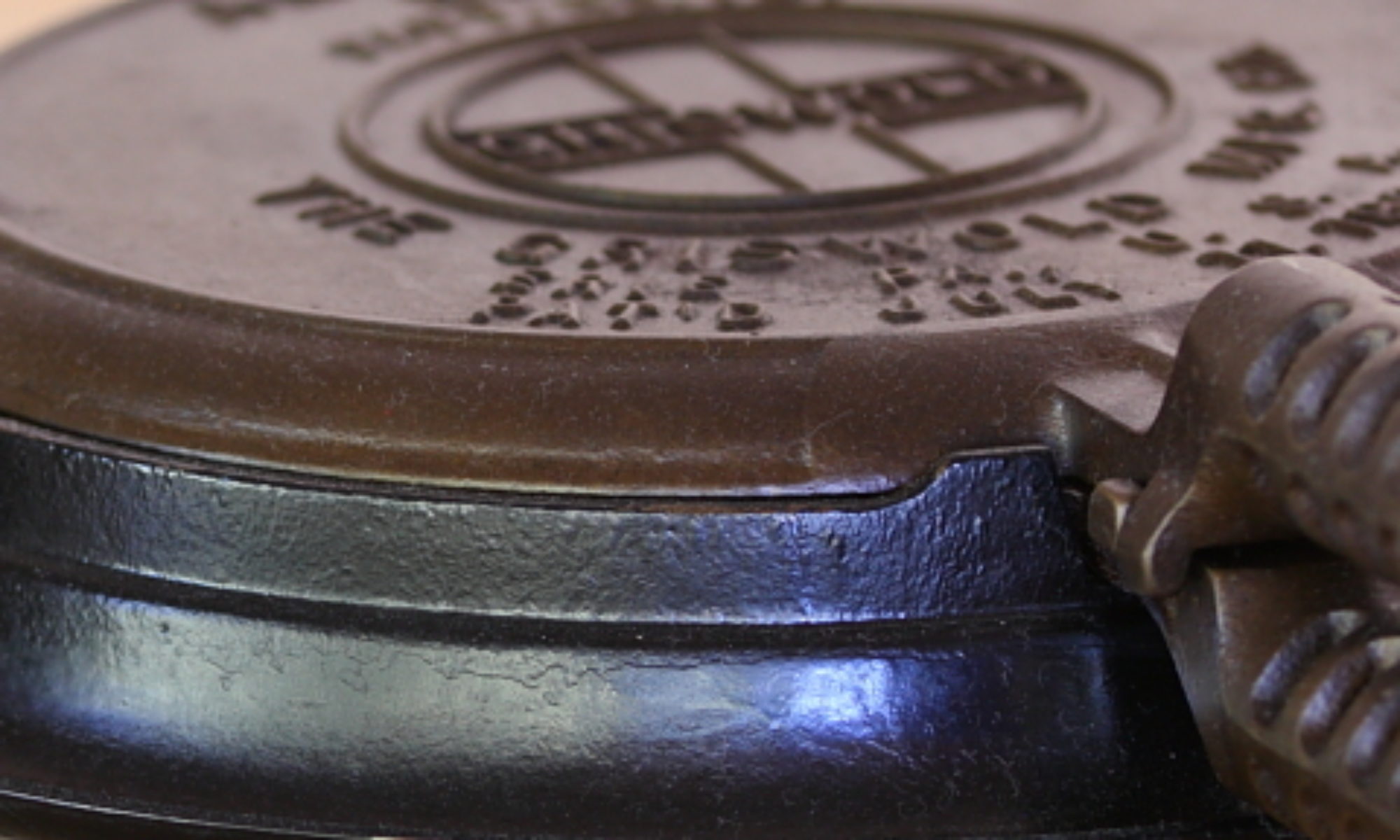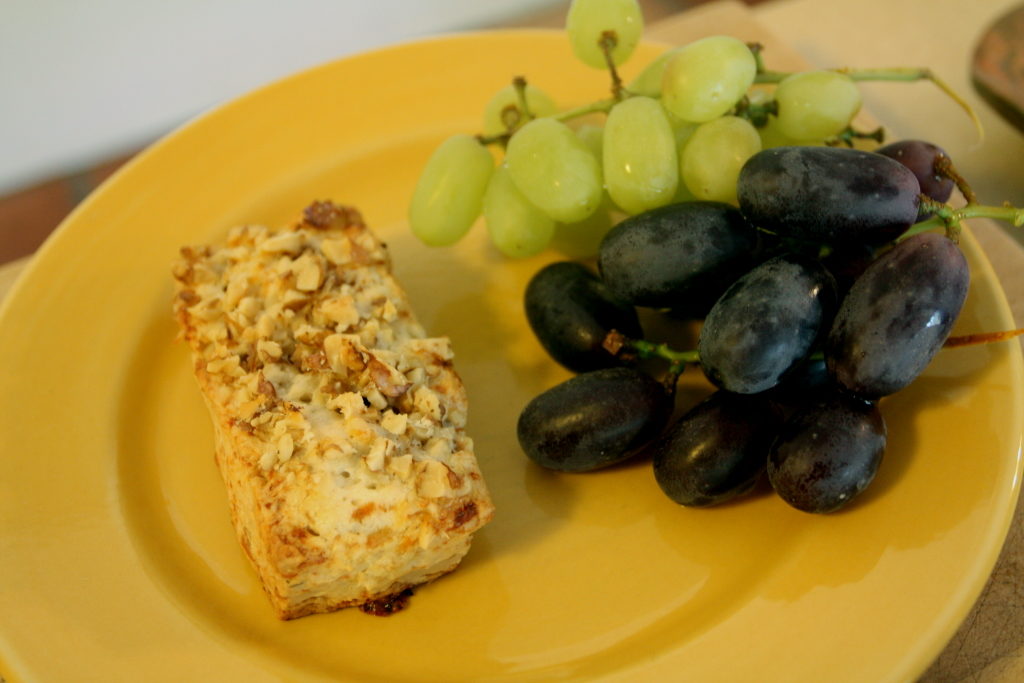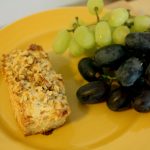
We had some heavy cream that was nearly a week old — it was still fine, but it wouldn’t last much longer — so, what to do? We’d bought it to make Bouchon Cheddar Scones to bring down for the volunteers at our weekly downtown walk, and we sure weren’t going to let it go to waste. We wanted a recipe that used heavy cream, but only needed about a cup. We thought about making a cream soup, but, after we tasted those scones again, we thought we’d make up a batch for ourselves.
But, we’d use Parmesan cheese and chopped walnuts, instead of Cheddar cheese. Basically, the same recipe, only we’d change up the flavors. So, if you make those Bouchon Cheddar Scones regularly, we figure that you’ll know just what to change to make a Parmesan and Walnut version. If not, just follow along and you’ll be scratchin’ out these scones on a regular basis.
From the above, it should be obvious that this is based on a recipe found in Bouchon Bakery, by Thomas Keller and Sebastian Rouxel.
Parmesan and Walnut Scones
Ingredients
- 107 g all-purpose flour (3/4 cup + 1 tsp)
- 196 g cake flour (1 1/2 cups + 1 Tbs)
- 8.1 g baking powder (1 1/2 tsp + 1/8 tsp)
- 1.6 g baking soda (3/8 tsp)
- 27 g granulated sugar (2 Tbs + 3/4 tsp)
- 3.6 g kosher salt (1 tsp)
- 132 g cold unsalted butter, cut into 1/4-inch cubes (9 Tbs + 1 tsp)
- 71 g heavy cream, plus more for brushing (1/4 cup + 1 Tbs)
- 69 g crème fraîche or homemade sour cream (1/4 cup + 1 Tbs) see note
- 144 g grated white Cheddar cheese (2 cups)
- 80 g walnuts, chopped (1/2 cup)
- 40 g chopped walnuts, for topping (1/4 cup)
Instructions
- Sift the flours, baking powder, baking soda, and sugar into the bowl of a stand mixer fitted with the paddle attachment. Add kosher salt and mix for about 15 seconds.
- Add butter pieces and pulse to start combining, then mix on low until butter is completely incorporated, about 3 minutes. If there are visible butter pieces remaining, break them up and mix in with your fingers.
- With mixer on low, slowly add cream and crème fraîche. Mix until all ingredients are moistened and dough forms around the paddle, about 30 seconds.
- Add cheese and walnuts and pulse until mixed.
- Turn out dough onto a work surface, and, using the heel of your hand and a dough scraper, press the dough together to form a 7x9-inch rectangle. Wrap in plastic, and refrigerate for 2 hours.
- Cut dough lengthwise to form two 9x4 1/2 inch strips, then cut each strip into 6 bars, each 4 1/2 x 1 1/2 inches in size. Place on a baking sheet lined with a silicone baking mat or parchment, wrap in plastic, and freeze at least 2 hours, but preferably overnight.
- (Once frozen, the scones can be placed in a plastic bag and kept frozen for a month.)
- Preheat oven to 350°F. Place a rack in the center of the oven and line a baking sheet with parchment.
- Arrange frozen scones on baking sheet, leaving about an inch of space between them. Brush with heavy cream and top with chopped walnuts.
- Bake 33 to 36 minutes, rotating front to back halfway through, or until scones are golden brown.
- Let scones cool on the baking sheet before serving.
Notes
Ingredient discussion:
First, we know that a lot of people may be intimidated by having the measurements listed by weight. Some of you might say that weighing ingredients is too difficult. Well, we heard that question posed to Thomas Keller, and he said, “I don’t see the issue with weighing ingredients; after all, most people weigh themselves once a week without trouble.” When we started weighing ingredients (for bread), we, too, thought it was more trouble. Since then, we’ve changed 180° and weigh our ingredients whenever possible. It makes baking much, much easier; you’ll see that below when we sift the dry ingredients. As you know by now, Parmesan cheese does not come pre-grated in a green can, and using unsalted butter for baking helps ensure your baked goods don’t taste like salt licks. Finally, crème fraîche is pricey, but scratched sour cream is almost identical (and super easy).
Procedure in detail:
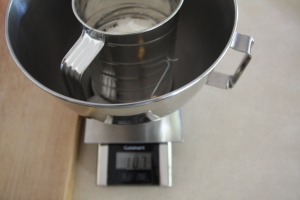
Sift drys. Really, the first step should be mise en place (get everything ready), but we wanted to call out the dry ingredients and how we measured and sifted them in one easy step We’ll go through that in some detail. First, set the sifter in the bowl of a stand mixer and set the bowl on your scale. Tare the scale (set it to 0), and spoon the all-purpose flour into the sifter until it reads 107 g. Tare the scale, and measure out 19 g of cake flour the same way. Repeat for the sugar. Next, measure and add the baking powder and baking soda (we do this by volume, because our scale doesn’t measure tenths of a gram). Now, all the dry ingredients are measured in the sifter, and ready to go, so pick it up and sift. Easy. Once you’ve sifted the dry ingredients, add the kosher salt.
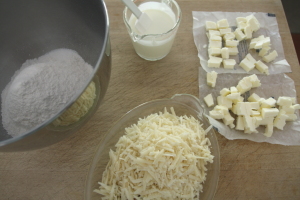
Mise en place. Measure and chop the butter. Measure out the walnuts and cheese. And, finally, measure out the cream and crème fraîche. We measure the cream and crème fraîche into a measuring cup, and stir the two together. There, now we’re ready to begin. This is another step that, when we started baking, we weren’t sure it was worth the trouble. Again, we were wrong. Getting everything measured and ready makes baking a pleasure and everything goes so smoothly. Get in the habit now and you’ll see, too.
Mix drys. Place the bowl of drys on a stand mixer fitted with a paddle, and, remembering that you didn’t sift in the salt (the crystals are too large to fit through a sifter), turn the mixer on for 15 seconds to mix in the salt. Once mixed, you can turn off the mixer.
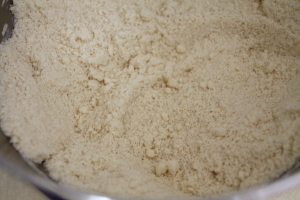
Add butter. Distribute the butter pieces over the top of the dry ingredients. Now, pulse the mixer to start working in the butter. Pulse, pulse, pulse. Keep pulsing until it doesn’t look as if the flour will poof over the top of the bowl when the mixer’s turned on. Turn the mixer on low and let it run for 3 minutes. By then, all the butter will be cut into the dry ingredients and it will look like coarse cornmeal.
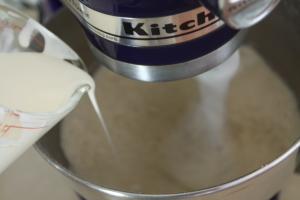
Add creams. With the mixer on low, slowly pour in the cream and crème fraîche. In about 30 seconds, the dough will come together and cling to the paddle. When that happens, turn off the mixer.
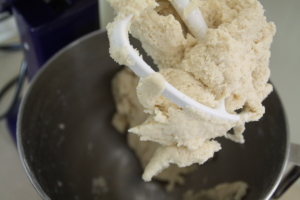
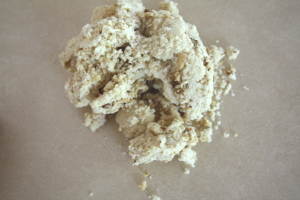
Add cheese and nuts. Pour the cheese and nuts into the mixer, then give it a few pulses to fold and mix everything together.
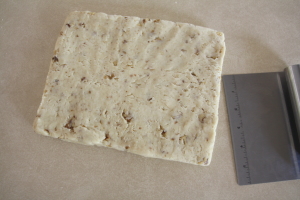
Shape. Scrape the dough out of the bowl and onto a clean work surface. Using the heel of your hand and a dough scraper, shape the dough into a rectangle that’s roughly 7×9 inches in size.
Refrigerate. Wrap the dough in plastic and place it in the refrigerator to chill for about 2 hours.
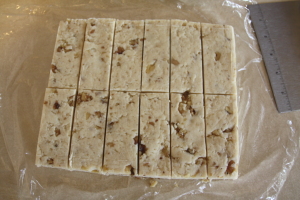
Cut. Once the dough is chilled, take it out and place it back on the work surface. Trim off the edges, since they don’t rise as well (bake them as a chef’s snack). Cut the dough in half length-wise to make two rectangles, each about 3 1/2 x 9 inches. Then cut each rectangle cross-wise into six equal pieces about 3 1/2 by 1 1/2 inches in size. Transfer each to a baking sheet lined with parchment or a silicone baking mat, leaving space between each scone.
Freeze. Wrap everything in plastic and place in the freezer until solid, at least 2 hours, but preferably overnight. Yep, scones for breakfast! After the 2 hours, you can transfer the scones to a plastic bag and they’ll keep in the freezer for up to a month.
Preheat oven to 350°F. Move a rack to the center of the oven and line a baking sheet with parchment (preferred) or a silicone baking mat.
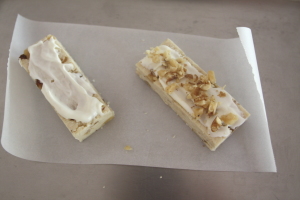
Top. Place scones on the prepared baking sheet, leaving about an inch of space between them, brush the tops with heavy cream, then sprinkle on the chopped walnuts.
Bake. Slide into the oven and bake, rotating halfway through, until golden brown and puffed, about 33 to 36 minutes.
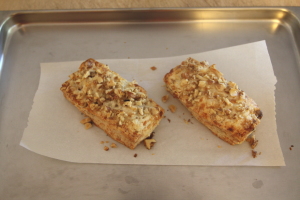
Cool. Let the scones cool completely on the baking sheet before serving.
As we expected, these scones are super! And, with that careful measuring, they just work. It might seem odd to be using a mixer to make scone dough (yeah, we’ve read the recipes that say scones need a light touch, no overworking, and possibly the effects of the light of full moon to turn out), but it just works. Perfectly. The first time, and every time. An easy five stars.
